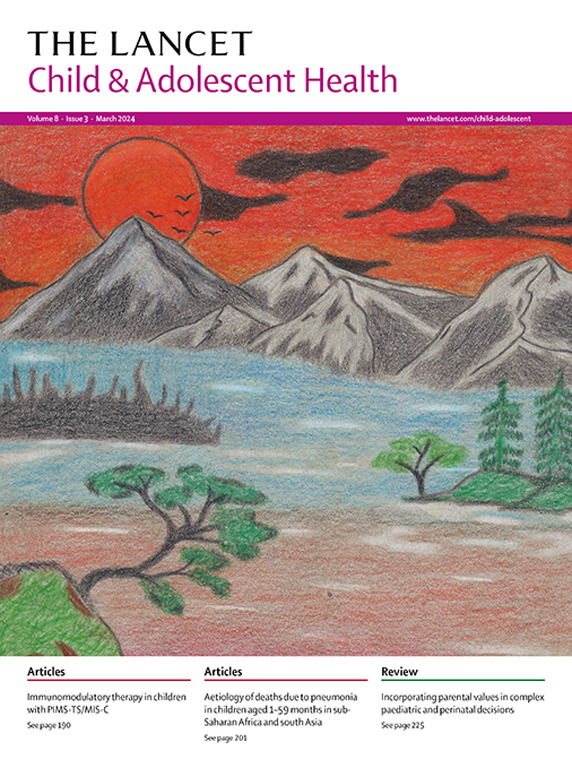澳大利亚新南威尔士州产前接触毒品和家庭外照料儿童的学校成绩:基于人群的回顾性队列研究
摘要
背景产前药物暴露(PDE)是一个全球性的公共卫生问题,它与儿童保护服务的需求密切相关,包括家庭外照料(OOHC)。我们的目的是评估 PDE 儿童(包括患有和未患有新生儿禁欲综合征 [NAS])的学校成绩,以及学校成绩与 OOHC 的关联。方法利用关联的人口健康、OOHC 和学校测试数据,我们比较了 2001 年至 2020 年期间出生在新南威尔士州(NSW)、在 2008 年 1 月 1 日至 2021 年 6 月 30 日期间至少完成过一次 NAPLAN 测试的 PDE 患儿在澳大利亚标准化课程测试--全国识字和计算能力评估计划(NAPLAN)--中的成绩,这些测试分别在 3 年级(8-9 岁)、5 年级(10-11 岁)、7 年级(12-13 岁)或 9 年级(14-15 岁)进行。关联数据集包括新南威尔士州围产期数据收集(出生数据)、新南威尔士州住院病人数据收集(医院诊断)、新南威尔士州教育标准局(NAPLAN 分数)、新南威尔士州家庭和社区服务数据集-KiDS 数据收集(OOHC 信息)、新南威尔士州心理健康流动数据收集以及新南威尔士州出生、死亡和婚姻登记处。主要结果是各年级在任何测试领域(数学、语言、写作和拼写)的得分高于或低于国家最低标准(NMS),比较有和没有PDE(PDE组中有或没有NAS)以及有和没有OOHC接触的儿童得分低于NMS的相对风险。此外,还调查了PDE队列和非PDE队列中OOHC与高于NMS评分的可能性之间的关系。在PDE队列中,3192名儿童被诊断为NAS,644名儿童未被诊断为NAS。在 897 487 名儿童中,有 1755 名(45%-8%)患有 PDE 的儿童需要进行 OOHC,而没有 PDE 的儿童有 12880 名(1%-4%)需要进行 OOHC。从第 3 年(风险比为 2-72 [95% CI 2-58-2-76])到第 9 年(2-36 [2-22-2-50]),患有 PDE 的儿童比未患有 PDE 的儿童更有可能在任何领域得分低于 NMS。无论是否确诊为 NAS,其表现都相似(第 3 年:0-96 [0-84-1-10];第 9 年:0-98 [0-84-1-15])。在对混杂因素进行调整后,与没有PDE的儿童相比,有PDE但没有NAS的儿童(0-57 [0-45-0-73])和NAS儿童(0-58 [0-52-0-64])在第9年得分超过NMS的可能性降低了,与没有OOHC的儿童相比,接受OOHC的儿童(0-60 [0-57-0-64])得分超过NMS的可能性也降低了。在患有多动症的儿童中,经混杂因素调整后,与未接受 OOHC 治疗的儿童相比,接受 OOHC 治疗的儿童从三年级(1-01 [0-92-1-11])到九年级(0-90 [0-73-1-10])的得分高于 NMS 的可能性相似。相比之下,在没有PDE的儿童中,从3年级(0-78 [0-76-0-80])到9年级(0-58 [0-54-0-61]),接受OOHC治疗的儿童比未接受OOHC治疗的儿童得分高于NMS的可能性更小。无论是否患有 OOHC,成绩差的风险都持续存在。这一发现突出表明,所有患有多动症的儿童都需要接受长期、文化敏感和积极主动的支持,以提高生活成功率。资助SPHERE Mindgardens神经科学网络、澳大利亚红十字会、Alpha Maxx医疗保健公司、综合健康与社会护理卓越研究中心、国家健康与医学研究委员会和悉尼大学。Background
Prenatal drug exposure (PDE) is a global public health problem that is strongly associated with the need for child protection services, including placement into out-of-home care (OOHC). We aimed to assess school outcomes for children with PDE (both with and without neonatal abstinence syndrome [NAS]) and the association of school performance with OOHC.
Methods
Using linked population health, OOHC, and school test data, we compared results on the Australian standardised curriculum-based test, the National Assessment Program—Literacy and Numeracy (NAPLAN), for children with PDE who were born in New South Wales (NSW) between 2001 and 2020 and had completed at least one NAPLAN test between Jan 1, 2008, and June 30, 2021, administered in Year 3 (age 8–9 years), Year 5 (age 10–11 years), Year 7 (age 12–13 years), or Year 9 (age 14–15 years). Linked datasets included NSW Perinatal Data Collection (birth data), NSW Admitted Patient Data Collection (hospital diagnoses), NSW Education Standards Authority (NAPLAN scores), NSW Family and Community Services Dataset—KiDS Data Collection (OOHC information), NSW Mental Health Ambulatory Data Collection, and NSW Registry for Births, Deaths, and Marriages. The primary outcome was scoring above or below the National Minimum Standard (NMS) in any test domain (mathematics, language, writing, and spelling) at each year level, comparing the relative risk of scoring below NMS between children with and without PDE (and with or without NAS within the PDE group), and with and without OOHC contact. The association between OOHC on the likelihood of scoring above NMS was also investigated for PDE and non-PDE cohorts.
Findings
The PDE cohort included 3836 children, and the non-PDE cohort included 897 487 children. Within the PDE cohort, 3192 children had a NAS diagnosis and 644 children had no NAS diagnosis. 1755 (45·8%) children with PDE required OOHC compared with 12 880 (1·4%) of 897 487 children without PDE. Children with PDE were more likely than children without PDE to score below NMS in any domain from Year 3 (risk ratio 2·72 [95% CI 2·58–2·76]) to Year 9 (2·36 [2·22–2·50]). Performance was similar regardless of a NAS diagnosis (Year 3: 0·96 [0·84–1·10]; Year 9: 0·98 [0·84–1·15]). The likelihood of scoring above NMS in Year 9 was reduced for children with PDE and without NAS (0·57 [0·45–0·73]) and NAS (0·58 [0·52–0·64]) compared with those without PDE, and also for children who received OOHC (0·60 [0·57–0·64]) compared with those without OOHC, when adjusted for confounders. Among children with PDE, those receiving OOHC had a similar likelihood of scoring above NMS compared with children who did not receive OOHC, from Year 3 (1·01 [0·92–1·11]) to Year 9 (0·90 [0·73–1·10]), when adjusted for confounding factors. By contrast, among children without PDE, those receiving OOHC were less likely to score above NMS than those who did not receive OOHC, from Year 3 (0·78 [0·76–0·80]) to Year 9 (0·58 [0·54–0·61]).
Interpretation
Compared with children without PDE, school performance in children with PDE—regardless of whether they were diagnosed with NAS—is poor, and the gap widens with age. The risk of poor performance persists regardless of OOHC status. This finding underscores the need for all children with PDE to receive long-term, culturally sensitive, and proactive support to improve life success.
Funding
SPHERE Mindgardens Neuroscience Network, Australian Red Cross, Alpha Maxx Healthcare, Centre for Research Excellence for Integrated Health and Social Care, National Health and Medical Research Council, and University of Sydney.

 求助内容:
求助内容: 应助结果提醒方式:
应助结果提醒方式:


